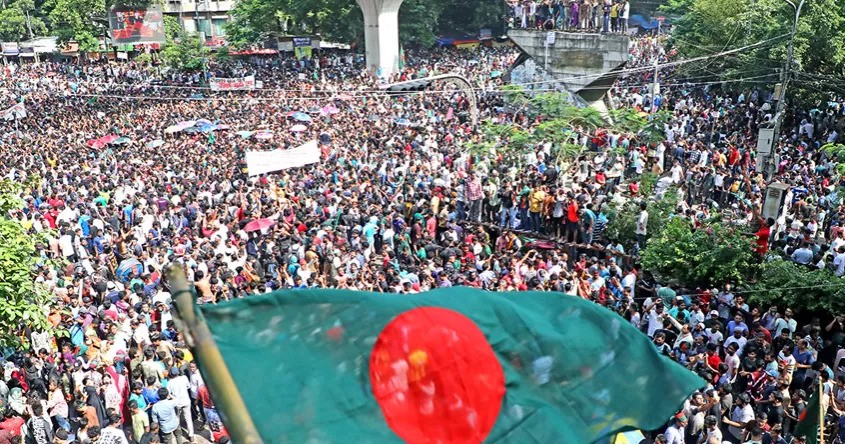Today marks the first anniversary of the historic July 36, a symbolic date students set for a revolution that Bangladesh witnessed last summer. July 36 is a ‘Bangla Spring’, a compelling generational saga of the inexhaustible power of youth, the poignant tale of a sea of people, a seething mass of legs and arms in street demonstrations with a shimmering political cause—the change of an authoritarian regime. August 5 was the culmination of July 36, a D-Day for the change-makers, a big day for releasing their discontent that was smouldering for years and venting their emotion that long remained pent-up.
The mass uprising was staged by students in Bangladesh for an exactly two-month timeline from June 5 to August 5, thereby uprooting a deep-seated autocracy. What began as an anti-quota student demonstration quickly escalated into a full-scale, multigenerational movement across the country. Unarmed civilians, led mainly by intrepid youth who refused to accept a corrupt regime, filled the streets of Dhaka and in other districts. The regime responded with the use of brute force, resulting in more than 1,400 deaths and thousands wounded. Yet, the students and their supporters stood firm, managing to topple a powerful regime that stage-managed three “dummy” midnight elections to stay in power.
This article, based on my firsthand experience of the clashes, delves into a chilling account of a different July, a transformational July that gave birth to a new Bangladesh through the overthrow of a long-held regime with the seismic power of a youthquake on 5 August 2024. The moot point is that the nation still wonders how a plain quota-reform movement in July 2024 fast escalated into a high-voltage upheaval in the sweltering heat of midsummer that rocked the once unassailable political superstructure of the Sheikh Hasina regime!
A turbulent July that I keenly observed first as an eyewitness and second as a journalist from its close range at Paltan, the flashpoint of political activities in the capital, and its contiguous neighbourhoods–Bijoynagar, Baitul Mukarram, Gulistan, Motijheel and Segunbagicha areas, every day in daytime and at night. I have not seen the glorious ’71, but I have seen the cruellest ’24. I saw the brutality, the savagery of ’24 and the gruelling pains people underwent in the absence of security of their lives and property.
I saw how Bangladesh bled for more than a fortnight from July 16 until ‘July 36’ and a paradigm shift in the nature of the youth-led one-point movement for the-then government’s ouster. I saw how a regime could be so ruthless in all its desperation, capacity and force to cling to power at any cost. I also saw how determined the unarmed but resolute students and the masses could be in their push for the change of a despotic regime even at the cost of blood.
The discriminatory job quota protest on June 5 and its escalation in mid-July before its culmination on August 5. The rot began with incendiary remarks about the student protesters by the high and mighty head of government during her post-China tour briefing in the evening of July 14. Street protests turned into street fights with student demonstrators on one side and police-Chhatra League activists on the other. The first victim of this clash was Abu Sayeed followed by five others elsewhere on July 16.
The procession of deaths did not cease. Hundreds of casualties and arrests followed crackdowns by security forces across the country. Things began to take a turn for the worse every passing day. July 19 was a tragic day that still sticks in my mind. It was a bloody black Friday. It seemed to me that all hell broke loose with the prolonged police firing of rubber bullets, sound grenades, tear-gas canisters and, and the howls of the injured. The air was hung heavy with the smell of burning tyres and other inflammables in streets strewn with brick chips, stones, bottles and missiles. I still hear the rumble of patrol cars on streets.
The eight-minute walking distance from a Purana Paltan Lane to the Paltan roundabout seemed a long haul for me to reach. The bedlam began much ahead of Friday’s Juma prayers. People were seen running for shelter from buckshot fired by lawmen. Three people were shot dead at the mouth of Aristopharma Lane around 2:30 pm. As I ventured to go to my Financial Express office at Paltan at 4:00 pm, I found myself on a blood-stained surface. In an eerie situation, I took my curfew pass and my office ID in my hands in a vain attempt to save myself from harm’s way. Black smoke was billowing out from combustibles burned on all roads leading to Paltan. I was making a step ahead and then turning back 10 steps. An uneasy calm prevailed in the area after security forces spilled blood.
Bangladesh saw its rebirth on July 36, a fitting metaphor for a powerful turning point in the country’s history of political turmoil. The July 36 political changeover installed a transitional government, led by Muhammad Yunus, with an eye to building a just society, ensuring social justice, ending political deadlock, systemic corruption and institutional paralysis. One year into the uprising, it is time for taking stock of the reforms the interim administration committed to make. It is time for proper and timely execution of the long-awaited ‘July Charter’ being unveiled by the chief adviser today.
Once again before summing up, it is time for all political parties to reach a consensus over shared national issues as the country is heading for the 13th parliamentary election in a participatory and credible manner. However, the bloody memories of the turbulent July will remain vivid in our collective psyche forever. Long live new Bangladesh for a transformative change in all spheres of public life.


